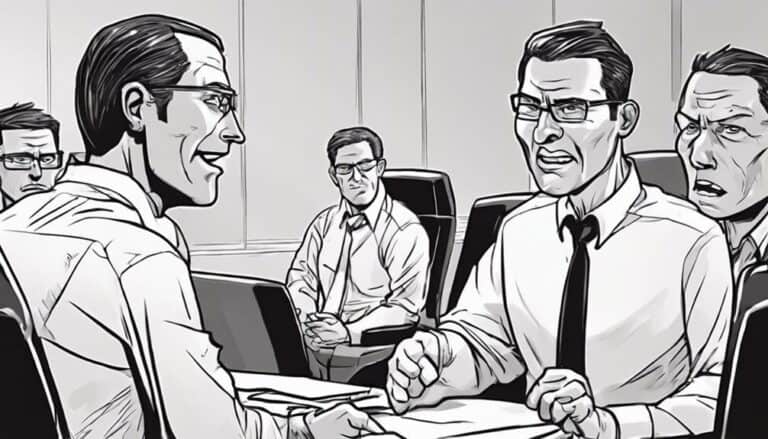When it comes to enhancing your nonverbal communication skills in a leadership setting, focusing on body language, facial expressions, and gestures is key.
But what about the subtler aspects of nonverbal cues that can truly elevate your leadership presence?
By delving into strategies that go beyond the basics, you can further refine your ability to connect, influence, and lead effectively within your team.
Key Takeaways
- Practice mirroring positive nonverbal cues for rapport and trust building.
- Seek feedback to pinpoint areas for nonverbal improvement.
- Use video analysis and workshops to enhance nonverbal skills.
- Experiment with varied nonverbal cues to gauge communication impact.
Importance of Nonverbal Communication Skills
Understanding the pivotal role of nonverbal communication skills in leadership is essential for fostering effective communication and establishing a strong leadership presence. In leadership settings, nonverbal cues can speak louder than words, accounting for over 70% of communication effectiveness. Your nonverbal communication, including gestures, eye contact, facial expressions, and posture, can greatly enhance your leadership presence among team members.
By improving your nonverbal communication skills through practices like mirroring and matching gestures with verbal messages, you can convey confidence, trustworthiness, and engagement more effectively. Controlling your nonverbal communication is key as it significantly impacts how you're perceived and followed by your team. Being mindful of the nonverbal cues you display can make a substantial difference in how your leadership is perceived, ultimately influencing the success of your leadership endeavors.
Mastering nonverbal communication can elevate your leadership impact and strengthen your connection with your team members.
Enhancing Body Language Signals
To enhance your body language signals effectively, focus on aspects like posture, facial expressions, eye contact, gestures, and proximity to others. When it comes to posture, make sure you stand or sit upright to convey confidence and authority. Matching appropriate facial expressions to the tone of your message can show engagement with your audience. Good eye contact is important in a leadership setting to establish trust, demonstrate active listening, and convey interest in the conversation. Gesturing naturally and purposefully can help emphasize key points, but be cautious of excessive movements that may distract. Additionally, be mindful of your proximity to others, adjusting it according to cultural norms and respecting personal space to guarantee comfort and respect during interactions.
| Aspect | Importance | Tips |
|---|---|---|
| Posture | Conveys confidence and authority. | Stand or sit upright; avoid slouching. |
| Facial Expressions | Show engagement and match message tone. | Use appropriate expressions for the context. |
| Eye Contact | Establish trust and demonstrate active listening. | Maintain good eye contact to convey interest. |
| Gestures | Emphasize key points effectively. | Gesture purposefully, avoiding excessive movements. |
Building Trust Through Nonverbal Cues
Building trust through nonverbal cues involves mastering the art of maintaining consistent eye contact, using open body language, mirroring positive signals, being mindful of facial expressions, and adjusting physical proximity as needed.
- Maintain Eye Contact: Establish trust and engagement by keeping eye contact during leadership interactions.
- Open Body Language: Foster trust and approachability with uncrossed arms and a relaxed posture.
- Mirror Positive Cues: Enhance connection by mirroring positive nonverbal signals like nodding and smiling.
- Facial Expressions: Convey sincerity, empathy, and confidence to strengthen relationships and trust.
- Adjust Proximity: Influence trust and communication effectiveness by adjusting physical proximity appropriately.
Mastering these elements of nonverbal communication can have a significant impact on your leadership interactions. By being mindful of these cues, you can build trust, enhance relationships, and improve overall communication effectiveness within your team.
Nonverbal Communication in Leadership Success
To achieve success in leadership, mastering nonverbal communication skills is paramount as it accounts for over 70% of all communication, greatly impacting how leaders are perceived and able to connect with their team.
In a leadership setting, your nonverbal cues play an essential role in conveying your message effectively. Maintaining good eye contact shows attentiveness and helps in building trust with your team.
Utilizing open body language, such as a relaxed posture and appropriate gestures, conveys confidence and approachability, fostering a positive environment within your team. Being mindful of your facial expressions is critical as they influence how your messages are received by team members.
Additionally, paying attention to proximity and physical cues, like standing or sitting closer to your team during interactions, signifies your involvement and strengthens the connection with your team. By honing your nonverbal communication skills in these areas, you pave the way for leadership success and establish a strong bond with your team.
Strategies for Nonverbal Skill Improvement
Enhance your leadership effectiveness by implementing targeted strategies to improve your nonverbal communication skills. Here are some effective strategies for leaders to enhance their nonverbal communication skills:
- Practice mirroring positive nonverbal cues like maintaining eye contact and using open body language to build rapport with your team members.
- Seek feedback on your nonverbal communication from peers or mentors to identify areas for improvement and adjust accordingly.
- Utilize video recordings of your presentations or meetings to analyze your nonverbal behaviors and make targeted enhancements.
- Attend workshops or training sessions focused on nonverbal communication to learn effective techniques and strategies for leadership settings.
- Experiment with different nonverbal cues, such as hand gestures or facial expressions, to gauge their impact on communication effectiveness and adjust as needed.
Conclusion
So, now that you've learned all about improving your nonverbal communication skills as a leader, you're all set to make a great impression… or not. Just kidding!
With these strategies in mind, you'll be able to effectively convey your messages and build stronger connections with your team.
Remember, actions speak louder than words – unless you're a mime, of course!

